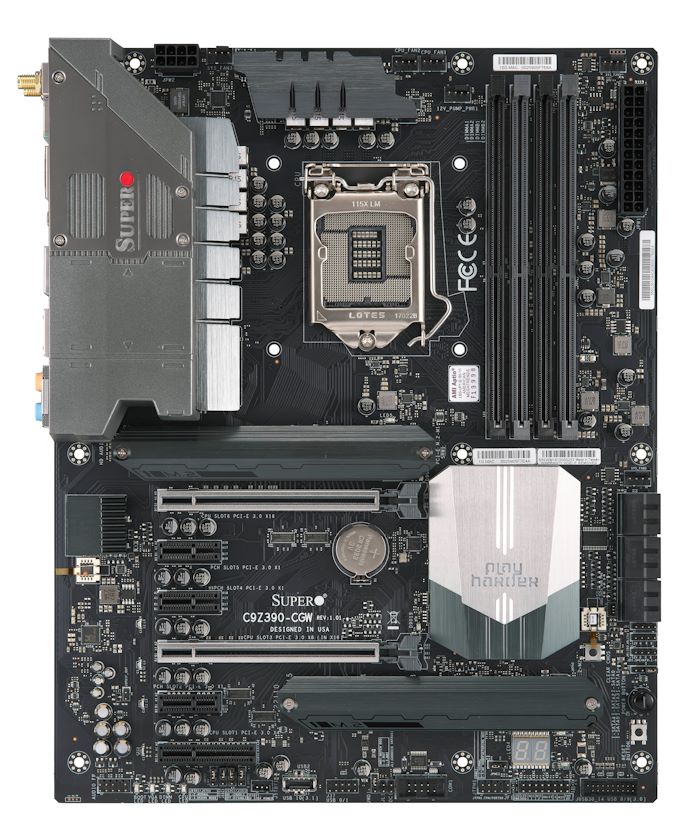Intel Z390 Motherboard Overview: 50+ Motherboards Analyzed
by Ian Cutress & Gavin Bonshor on October 8, 2018 10:53 AM EST- Posted in
- Motherboards
- Intel
- MSI
- Gigabyte
- ASRock
- EVGA
- Asus
- NZXT
- Supermicro
- Z390
Supermicro C9Z390-CGW
The SuperO C9Z390-CGW is an ATX sized model which is targeted towards gamers looking to utilize some of the more premium features as the PGW model, but with some obvious cutbacks. The C9Z390-CGW has two full-length PCIe 3.0 slots which operate at ether x16/x4 with the bottom PCIe 3.0 x4 slot populated at the bottom and/or x16/x8 and the bottom slot is disabled when the second full-slot is in use. bottom. Sandwiched in between the full-length slots are three PCIe 3.0 x1 slots with a pair of M.2 PCIe 3.0 x4 slots with heatsinks also among the PCI. Other storage options include six SATA ports with support for RAID 0, 1, 5 and 10 arrays. Memory support is slightly lower than the PGW with the CGW supporting up to DDR4-3866 and up to a maximum capacity of 64 GB across four available slots. Like the flagship PGW model featured above, the CGW also features five 4-pin fan headers with one of the headers being designated to water cooling pumps.
On the rear panel of the C9Z390-CGW are three USB 3.1 Gen2 Type-A ports with an additional Gen2 Type-C port and two USB 3.0 Type-A ports making up the rest of the USB connectors. A total of two LAN ports are present with one coming via an Aquantia AQC107 10G NIC with the other being controlled by an Intel I219V Gigabit chip. The five 3.5 mm audio jacks and S/PDIF optical out are powered by a Realtek ALC1220 HD audio codec and the board also includes a PS/2 combo port, two DisplayPort 1.2 outputs, a single HDMI 1.4 output and two antenna connectors for the included 802.11ac dual-band Wi-Fi adapter; this also provides users with Bluetooth 5 connectivity.
The Supermicro C9Z390-CGW takes certain elements of the flagship C9Z390-CGW such as 10G Aquantia networking, dual-band 802.11ac Wi-Fi connectivity with two full-length slots offering x16 bandwidth on both for unrestrictive bandwidth when running two-way CrossFire and SLI setups; it's quite likely the bottom PCIe 3.0 x4 shares bandwidth with the M.2 slots. The C9Z390-CGW slots right underneath the more comprehensive PGW, but as of yet initial pricing is currently unknown.












79 Comments
View All Comments
Smell This - Tuesday, October 9, 2018 - link
Much.Of.
The.
Same.
2 HSIO lanes per Gen 2 port and WiFi. Wow (rolling I-eyeballs) ...
MadAd - Tuesday, October 9, 2018 - link
58 motherboards, only 13 of which are smaller than ATX. When on earth are we going to move off this outdated oversized format? Its just more of the same every time, so depressing.gavbon - Wednesday, October 10, 2018 - link
13 is better than 0, or 12 :DMadAd - Wednesday, October 10, 2018 - link
Considering very small form formats (ITX) are harder to build for and only 7 are uATX, a size which is the most useful to transition away from ATX then no, it feels like an afterthought from a lazy industry. I mean who uses more than 1 main video card and 2-4 sticks of ram in a gaming PC these days? Even water builds into uATX isnt that hard to accomplish.After literally decades ATX should be a choice for edge cases not a mainstream build.
shaolin95 - Monday, October 22, 2018 - link
who cares about midge boards!Edkiefer - Wednesday, October 10, 2018 - link
All these MB with 2x 8 pin power inputs, is both mandatory and if so I guess new PSU will need 2x 8pin now.entity279 - Wednesday, October 10, 2018 - link
so it's ok to just buy SM motherboards now with them being involved in a security scandal?gavbon - Thursday, October 11, 2018 - link
I currently have the Supermicro C9Z390-PGW awaiting to go on the test bench next week, so from a consumers standpoint, I could potentially shed light on that board. As far as the Chinese/Supermicro/Spy scandal goes, I don't want to speculate without the finer details.eastcoast_pete - Wednesday, October 10, 2018 - link
Ian & Gavin, thanks for the overview.@ both - Question: I've read that Intel, to deal with its bad planning/capacity problems on 14 nm, has contracted the fabbing of some of its chipsets out to TSMC, specifically in TSMC's 22 nm tech. Is that correct, and did you have a chance to confirm that the new 390s used by these boards are indeed made by Intel on their 14 nm FinFET tech, or are they made by a contractor (TSMC)?
DanNeely - Wednesday, October 10, 2018 - link
AFAIK the chipsets being reverted to 22nm are using Intel's 22nm process in old unupgraded fabs. Doing so would be far less work than porting to a process from a different company; the latter would require massive rework to follow a completely different set of design rules.